
- What We Know About Aiki Jujutsu
- What We Know About Brazilian Jiu-Jitsu
- Key Elements Of Aiki Jujutsu
- Key Elements Of Brazilian Jiu-Jitsu
- Aiki Jujutsu Rankings & Levels
- Brazilian Jiu-Jitsu Rankings & Levels
- Aiki Jujutsu Vs. Brazilian Jiu-Jitsu Attire
- What A Typical Aiki Jujutsu Training Session Looks Like
- What A Typical Brazilian Jiu-Jitsu Training Session Looks Like
- Aiki Jujutsu Movies
- Conclusion: Aiki Jujutsu Vs. Brazilian Jiu-Jitsu
There are many different martial arts styles out there, each with their own unique benefits. Two popular styles are Aiki Jujutsu and Brazilian jiu-jitsu.
So which is better?
It really depends on what you're looking for in a martial art. In this blog post, we'll take a look at the key differences between aiki jujutsu and Brazilian jiu-jitsu to help you decide which one is right for you.
The main difference between Aiki Jujutsu and Brazilian Jiu-Jitsu is the emphasis on strikes and throws versus ground fighting. Aiki Jujutsu practitioners primarily focus on using their opponent's energy against them, utilizing joint locks and throws to control and disarm an attacker.
Brazilian Jiu-Jitsu, on the other hand, puts a strong emphasis on ground fighting and submission holds.
In terms of effectiveness in real-life self-defense scenarios, both Aiki Jujutsu and Brazilian Jiu-Jitsu can be equally useful. It ultimately depends on the individual practitioner's skills and ability to adapt their techniques to the situation at hand.
But let's look at these two disciplines in more depth.
Once we've done that, you can decide for yourself!
What We Know About Aiki Jujutsu
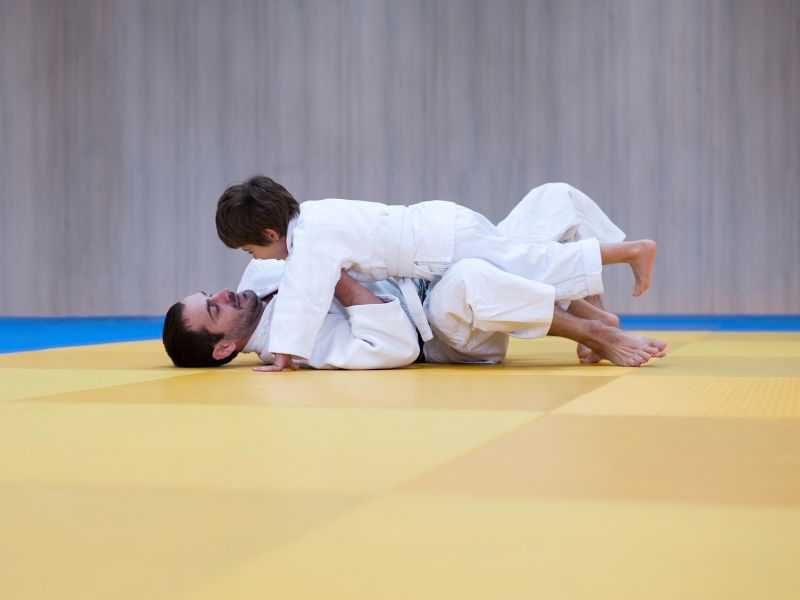
Aiki Jujutsu is a martial art that involves harmonizing your own energy with that of your opponent in order to redirect it in a way that suits your needs.
Instead of meeting force head-on, Aiki Jujutsu practitioners use Kempo-Jutsu's striking and evasive techniques to position themselves close to their opponents. They then follow up with linear, diagonal, or circular movements to redirect the opponent's energy.
Throwing techniques in Aiki Jujutsu rely heavily on Kempo-Jutsu's Atemi. In some instances, a skilled practitioner can apply Aiki Jujutsu throwing techniques by blending with their opponent's energy.
Aiki Jujutsu can be traced back to the Takenouchi Hisamori's Shinmei-ryu school of swordsmanship, which he founded in the early 1600s.
His student, Takeda Sokaku, is credited with creating Aiki Jujutsu from the techniques he learned from Hisamori. Sokaku passed on his knowledge to his son, Takeda Tokimune, who then continued to develop and teach the art until his death in 1943.
The art was further refined by Morihei Ueshiba, who created Aikido, a modernized version of Aiki Jujutsu.
Even today, Aiki Jujutsu can be used for self-defense or as a form of physical and mental exercise. Its excellent teachings regarding control over one's body and mind have made it a staple in the martial arts community.
What We Know About Brazilian Jiu-Jitsu

Brazilian Jiu-Jitsu is a grappling-based martial art that has its origins in Japan. It was created by Mitsuyo Maeda, a Japanese martial artist who studied under Judo founder Jigoro Kano.
Maeda eventually immigrated to Brazil, where he taught the techniques of Jiu-Jitsu to Gastão Gracie and his family.
The Gracie family then adapted and modified the techniques to effectively defend against larger opponents.
In the early 1990s, Brazilian Jiu-Jitsu exploded onto the mainstream martial arts scene when the Gracie family founded the Ultimate Fighting Championship (UFC).
Since then, BJJ has been proven to be a successful form of self-defense, both in the UFC and competitions, as well as in practical scenarios.
BJJ focuses on using leverage and technique rather than brute strength to defeat an opponent. This makes it an ideal martial art for smaller individuals who want to be able to defend themselves against larger opponents.
In addition to being an effective form of self defense, BJJ also has a strong emphasis on discipline and respect, both in the academy and outside of it. BJJ is also an amazing workout for people of any age and fitness level.
So regardless of if you're looking for a way to defend yourself or just want to get in shape, BJJ is a great option.
Of course, this is only a brief history and understanding of Aiki Jujutsu and Brazilian Jiu-Jitsu, but if you want to go deeper into either art, be sure to check out the following posts:
- Everything You Need To Know About Aiki Jujutsu
- Everything You Need To Know About Brazilian Jiu-Jitsu
Now, back to the comparison...
Let's look at the origins of the respective disciplines and then compare the key elements of their practices. You will be able to understand some of their similarities and differences a bit better afterward.
| Aiki Jujutsu | Brazilian Jiu-Jitsu | |
| Origins | Japanese | Brazilian |
Key Elements Of Aiki Jujutsu
One of the fundamental principles in Aiki Jujutsu is the use of leverage and balance to gain an advantage over one's opponent. This involves the strategic application of force and momentum to manipulate an opponent's body, making it easier to control and overpower them.
Another essential component of Aiki Jujutsu is the use of body movement and positioning.
By carefully positioning one's body in relation to the opponent, a practitioner can create openings for attacks or defensive maneuvers. This requires a high degree of spatial awareness and precision in movement.
Joint locks and throws are powerful techniques that can be used to subdue an opponent quickly and efficiently.
These maneuvers involve applying pressure to a joint or manipulating an opponent's balance to throw them to the ground. They require a thorough understanding of anatomy and a high degree of technical skill.
One of the most advanced techniques in Aiki Jujutsu is the ability to blend with the motion of an attacker. This involves moving in a way that allows a practitioner to avoid incoming attacks while simultaneously positioning themselves to counterattack.
It requires an acute awareness of an opponent's movements and a high level of skill in evasive maneuvers.
Next, up here in Aiki Jujutsu is breath control. By learning to regulate their breathing, practitioners can maintain their focus and energy levels, even in the face of physical exertion and stress.
Mental focus and calmness in the face of adversity are critical traits for any Aiki Jujutsu practitioner.
And speaking from personal experience, if you're knee deep into a fight, you'll want to know how to maintain a clear head and a calm demeanor, even in the face of obvious danger.
This requires mental fortitude and the ability to stay focused under pressure, the kind that Aiki Jujutsu will teach you.
Finally, one of the most powerful parts of this martial art is its ability to use an attacker's energy against them.
By skillfully redirecting an opponent's momentum, a practitioner can use their strength and force to overpower them. Of course, this requires a deep understanding of the techniques and a high degree of technical skill--which, trust me, your training will be able to give you in spades.
Key Elements Of Brazilian Jiu-Jitsu
- Grip Fighting: This is one of the most important aspects of Brazilian Jiu-Jitsu. Without a strong grip, it will be very difficult to submit your opponent. Grip fighting is also a great way to tire out your opponent and make them less effective.
- Takedowns: Takedowns are another hugely important aspect of Brazilian Jiu-Jitsu. There are many different takedowns you can use, but the most important thing is to take your opponent down to the ground where you have an advantage.
- Ground Fighting: Once you have taken your opponent down to the ground, you need to know what to do. This is where ground fighting comes in. There are many different techniques you can use to submit your opponent or make them tap out.
Another thing I think is important to look at is the different rankings and levels in each art. if you are looking to take up either Aiki Jujutsu or Brazilian Jiu-Jitsu, whether as a hobbyist or to compete, you need to understand the different levels of proficiency and what is required for testing and ranking.
Aiki Jujutsu Rankings & Levels
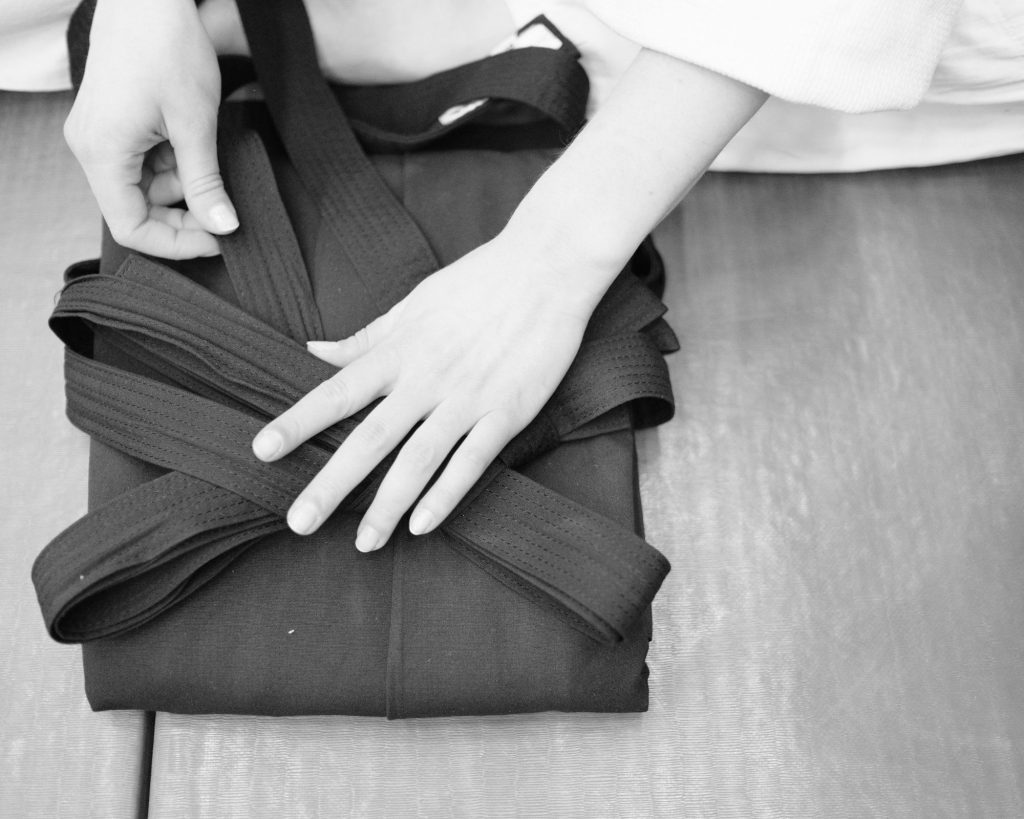
Aiki Jujutsu has its own ranking system, as you've likely already expected. It starts with the 10th Kyu white belt, which represents the beginner level. As one progresses, they move up the ranking system by earning colored belts and stripes.
The ranking system is divided into two categories: kyu and dan. Kyu represents the colored belts that one earns before reaching the black belt level. Dan represents the black belt levels.
The colored belt levels range from 9th Kyu white belt with a yellow stripe, all the way to 4th Kyu purple belt.
The amount of training required to earn these belts is pretty significant, in my opinion. IT ranges from 2 to 3 months, such as for the 9th Kyu white belt with a yellow stripe, to 15 to 21 months, like for the 4th Kyu purple belt.
The black belt levels start with the Shodan-Ho (Junior Black Belt) and progress to the highest level, which is the Godan (5th Degree Black Belt).
If you ask me, it's definitely not an easy feat to achieve: it normally takes years of dedication and training to reach the highest levels of the black belt ranking system.
If this is all a bit hard to visualize, don't worry; I've made a more detailed breakdown for you to see below:
| Rank | Color |
| 10th Kyu | White |
| 9th Kyu | White |
| 8th Kyu | Yellow |
| 7th Kyu | Blue |
| 6th Kyu | Green |
| 5th Kyu | Green |
| 4th Kyu | Purple |
| 3rd Kyu | Brown |
| 2nd Kyu | Brown |
| 1st Kyu | Brown |
| Shodan-Ho | Black |
| Shodan | Black |
| Nidan | Black |
| Sandan | Black |
| Yondan | Black |
| Godan | Black |
Brazilian Jiu-Jitsu Rankings & Levels
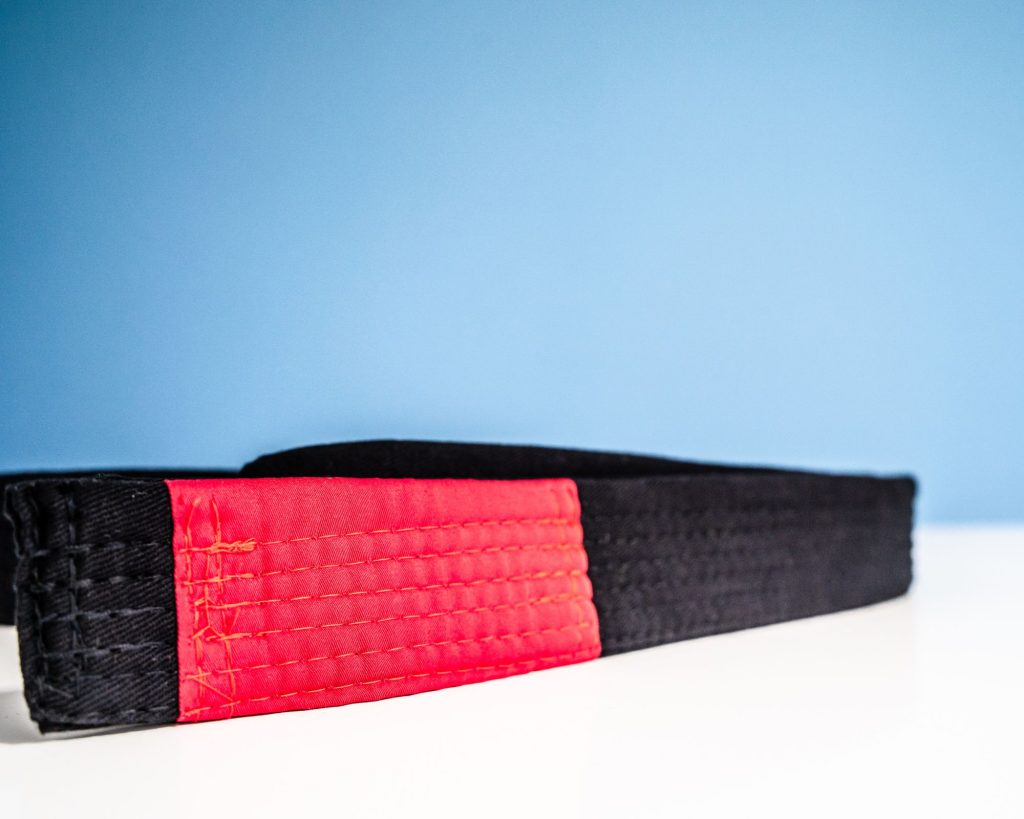
Brazilian Jiu-Jitsu has a unique system of ranks, which can be somewhat confusing for beginners. In order from lowest to highest, the ranks are: white belt, blue belt, purple belt, brown belt, and black belt.
The rank a practitioner holds is not indicative of their skill level; a white belt could be more skilled than a brown belt, and vice versa.
The first belt in Brazilian Jiu-Jitsu is the white belt. This rank is held by any practitioner new to the art and has no prerequisite.
A white belt's training will focus on the basics of Brazilian Jiu-Jitsu. That means learning how to position oneself on the ground, how to execute submissions and how to defend against them.
The second adult rank in Brazilian Jiu-Jitsu is the blue belt. At the blue belt level, students gain a wide breadth of technical knowledge and undertake hundreds of hours of mat-time to learn how to implement these moves efficiently. Definitely not easy!
The purple belt is the intermediate adult ranking in Brazilian Jiu-Jitsu. Aside from the exceptional belts awarded at the highest levels, brown belt is the highest ranking color belt in Brazilian Jiu-Jitsu.
The IBJJF requires a practitioner remain a purple belt for a minimum of 1.5 years before they can be promoted.
The coveted black belt is the highest ranking in Brazilian Jiu-jitsu. To achieve this rank, a practitioner must have an extensive knowledge of all aspects of Brazilian Jiu-jitsu and must have demonstrated proficiency in all areas of the art.
Aiki Jujutsu Vs. Brazilian Jiu-Jitsu Attire
This section simply compares the clothing and uniforms that practitioners wear in combat.
Aiki Jujutsu Attire:

In terms of attire, Aiki Jujutsu practitioners typically wear a traditional dogi and hakama. This affords them better gripping and movement during techniques.
Brazilian Jiu-Jitsu Attire:
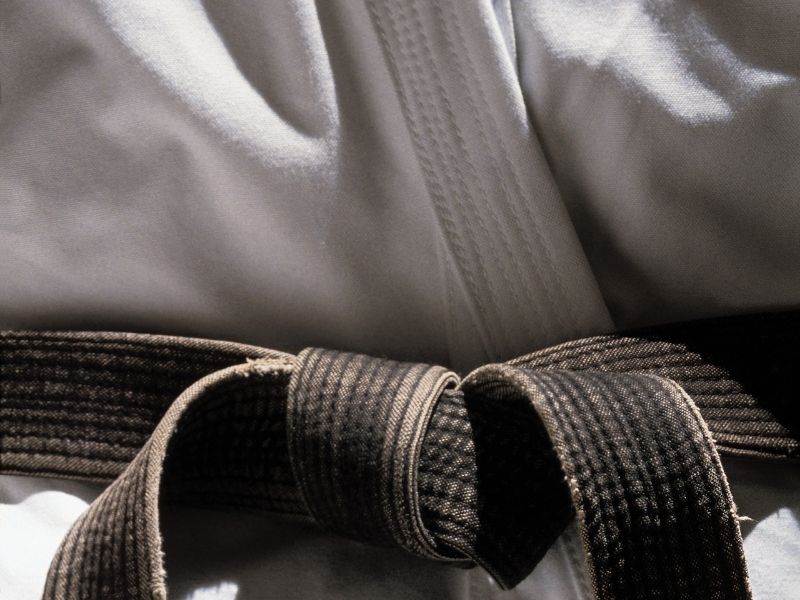
In Brazilian Jiu-Jitsu, practitioners wear a gi. A gi is a type of martial arts uniform made of cotton or similar material. The gi consists of a jacket, pants, and belt.
The jacket is wide open in the front and has a large lapel. The pants are baggy and have a drawstring waistband. The belt is usually white with a colored stripe running down the center.
What A Typical Aiki Jujutsu Training Session Looks Like
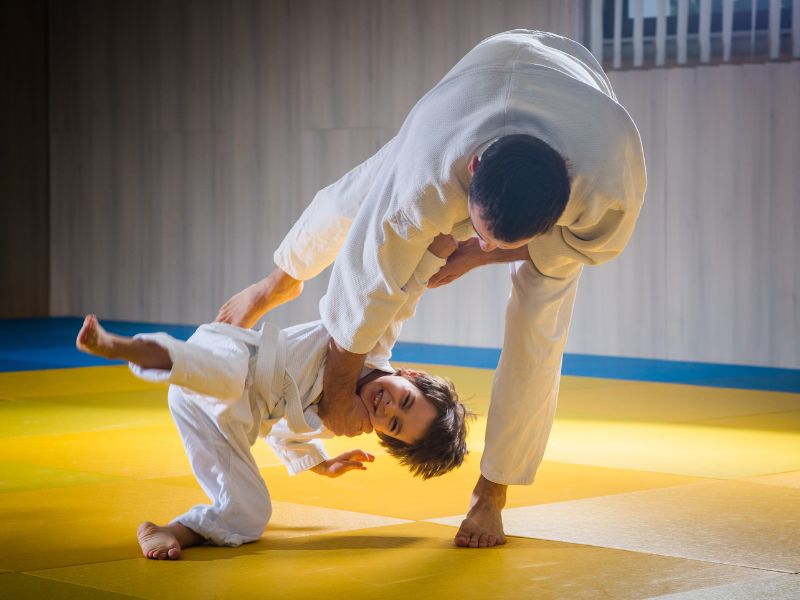
A typical Aiki Jujutsu practice session may start with a few minutes of warm-ups, such as joint rotations and light stretches. This is followed by practicing techniques, which may include throws, locks, and pins. The session usually ends with some relaxation exercises and a cool-down.
One of the most commonly used techniques in Aiki Jujutsu is the wristlock. This involves controlling an opponent's wrist and using their own momentum to throw them off balance.
In addition to physical technique, Aiki Jujutsu also emphasizes mental and spiritual development. This includes cultivating a strong mind-body connection and developing qualities such as patience and awareness.
What A Typical Brazilian Jiu-Jitsu Training Session Looks Like

A typical Brazilian Jiu-Jitsu practice session would typically involve a warm-up, drilling, positional sparring, and finally live rolling. The warm-up would usually consist of light exercises such as running, jumping jacks, and calisthenics.
The drilling would usually involve practicing techniques with a partner. The positional sparring would usually involve two people fighting for dominant positions on the ground. The live rolling would usually involve two people trying to submit each other.
If the last few sections have been a bit full-on or a bit too technical, you will like this next section! Why? Because who doesn't love a good martial arts flick?
Both Aiki Jujutsu and Brazilian Jiu-Jitsu have been featured in a number of films and TV shows, so if you want to learn more about them, then entertain yourself with the following 👊
Aiki Jujutsu Movies

These are some of my favorite movies and shows with Aiki Jujutsu in them:
- The Bourne Identity (2002)
- Kill Bill: Volume 1 (2003)
- The Protector (2005)
- The Matrix Reloaded (2003)
- 13 Assassins (2010)
- The Raid (2011)
And as for BJJ movies, you can have a look at some of the top ones here:
- John Wick (2014)
- The Raid: Redemption (2011)
- Kickboxer (1989)
- The Legend of Bruce Lee (2008)
- Enter the Dragon (1973)
- Undisputed III: Redemption (2010)
- Never Back Down (2008)
Conclusion: Aiki Jujutsu Vs. Brazilian Jiu-Jitsu

I hope you now have a deeper understanding of Aiki Jujutsu and Brazilian Jiu-Jitsu. In all truth, it is not about which discipline is "better" as they each have their pros and cons.
If you do plan on starting classes for either, please check out my other related posts, as I have tried my best to answer all the FAQs related to the art.
Feel free to share this post and any graphics you like, and of course, if you have any questions or thoughts, drop them below or shoot me an email, and I will be happy to assist 🙂
[author-box-jpx-fitness]
